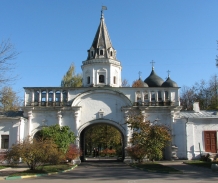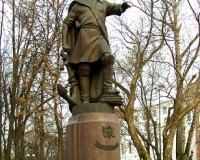Izmailovo: Royal Residence and Monument to Peter I in Izmailovo (1999)
Izmailovo has been known under this name since 1571. It belonged to a boyar family who became a new royal dynasty of Romanovs in 1613. In 1655, Izmailovo became the property of Aleksey Mikhailovich. After his death, the settlement and the palace estate were successively owned by Tsar Fyodor III Alekseevich, Tsarevna Sophia Alekseevna, and Tsar Ivan V Alekseevich.
The village was developed as an experimental subsistence farm for the palace which also included the Sovereign’s court. It was famous for its gardens and kitchen gardens, rare plants and fruit. It served as a ground for the first plant breeding experiments and produced grapes, melons and watermelons. Mills, meaderies and breweries were built to process agricultural products. A glass factory was built in the estate under the reign of Aleksey Mikhailovich and its products were used at the Tsar’s table. The palace zoo had rare animals, such as lions, tigers and elephants, and the poultry yard had swans and pelicans.
In 1671, the foundation of a cathedral dedicated to the Intercession of the Theotokos was laid on the site of the same-named wooden church in the royal estate. Consecrated in 1680, the cathedral is a huge five-domed temple with the facades decorated with colored tiles.
1671 saw the construction of a stone 14-arch bridge more than 100 meters long over the artificial Serebryany (Silver) Pond which was used to enter the estate (and was subsequently dismantled). In front of the bridge, there was built a three-level red-brick Mostovaya (Bridge) Tower which served simultaneously as the main entrance to the royal court and the cathedral bell tower.
A wooden Sovereign’s Mansion, as known from the surviving drawings, existed on the Izmailovo Island in the Serebryany (Silver) Pond before stone buildings began to be constructed. The construction of a new Sovereign’s Court began in 1676. The new palace was also wooden and consisted of 20 log buildings of different dimensions and heights resting on stone foundations. It is known that they served as palaces of Tsars Ivan and Peter, Tsarevna Sophia, Tsarina Natalia Kirillovna and other members of the royal family. An English boat found by young Tsar Peter I in one of the maintenance buildings in Izmailovo in 1688 went down in history as the “Grandfather of the Russian Fleet”. The Prosyanoy (Millet) Pond in Izmailovo was where Tsarevich Peter first learned sailing. Later, the boat was moved to St. Petersburg (it is still existent and exhibited at the Central Naval Museum).
In 1696, Izmailovo became a favorite residence of the widow of Tsar Ivan V Praskovia Fyodorovna and their daughter, the future Empress Anna Ivanovna, spent her childhood there. Peter I was a frequent visitor to his brother’s mansion, but he always stayed for a short period only.
A new stage in the revival of Izmailovo was under the reign of Peter I’s niece Anna Ivanovna, as it served as the residence of the Empress for two years.
In 1837, an almshouse for veterans of the Patriotic War of 1812 was founded on the island. Almshouse buildings designed by architect Konstantin Thon were erected on three sides around the Intercession Cathedral. The same architect also renovated the Front and Rear Gates and introduced changes to their appearance. The other constructions of the Sovereign’s Court were dismantled and their foundations were used for new buildings.
After 1917, the Military Almshouse buildings were adapted to set up a workers camp. In 1927, the Intercession Cathedral was closed. In 1930, the forest in Izmailovo was declared a park of culture and recreation. In 1960, Izmailovo became part of Moscow.
In 1987, a branch of the State Historical Museum was established on the island. 1990 saw the beginning of the Intercession Cathedral’s return to the Church.
A monument to Peter I was inaugurated in the former palace estate in 1999, and the inauguration ceremony was timed to coincide with the Navy Day. The monument was made by sculptor Lev Kerbel and architect Georgy Lebedev. Cast in bronze, a three meters high figure of Peter stands on a high granite pedestal. The statue of the young Tsar has a dynamic pose, depicting him dressed in working clothes, with his left arm stretched forward, his right arm resting on an anchor, and his left foot trampling a ship rope.
In 2007, the estate became part of the Moscow State Integrated Art and Historical Architectural and Natural Landscape Museum-Reserve.
In 2003 – 2005, a stylized “Tsar’s estate” was built to the design of architect Alexander Ushakov. The decoration of the buildings was designed using the drawings dating from the 17th century; however the Izmailovo Kremlin shopping and entertainment center does not look historically accurate.



